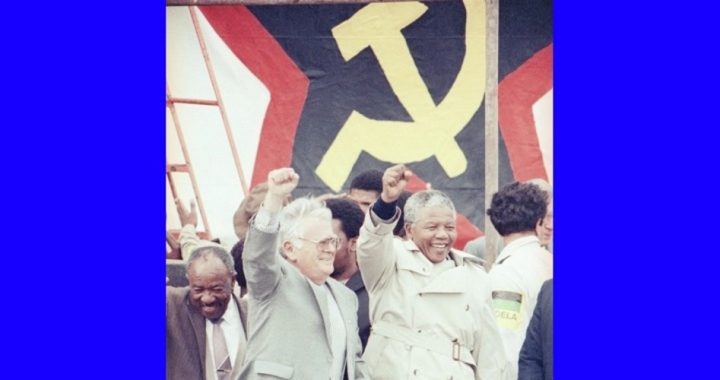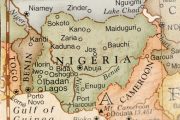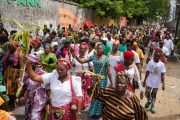
With the widely anticipated passing of South African revolutionary leader Nelson Mandela late Thursday, December 5, presidents and dictators from around the world — as well as everyday people, and especially the press — are in mourning. Lost amid the tsunami of praise and adoration, almost canonization even according to some of his supporters, however, is the truth about the man himself, who was, after all, still just a man.
The announcement of Mandela’s death was made by current South African President Jacob Zuma, the fourth leader of the so-called “rainbow nation” ushered in after the fall of Apartheid rule some two decades ago. “Our beloved Nelson Rolihlahla Mandela, the founding President of our democratic nation has departed,” said Zuma, a polygamous tribal chief who, amid never-ending corruption scandals, regularly sings “struggle” songs about murdering European-descent Afrikaners.
According to the current South African president, Mandela passed on “peacefully” in the company of his family late Thursday. “He is now resting. He is now at peace,” Zuma continued, adding that the deceased leader would receive a state funeral and flags would be flown at half-mast until then. “Our nation has lost its greatest son. Our people have lost a father. Although we knew that this day would come, nothing can diminish our sense of a profound and enduring loss.”
Like heads of state and the media around the world, Zuma celebrated Mandela’s alleged “tireless struggle for freedom” and how he “brought us together” in common cause. “Our thoughts are with his friends, comrades and colleagues who fought alongside Madiba over the course of a lifetime of struggle,” South Africa’s current president continued, offering the briefest of glimpses into the reality about Mandela that has been largely expunged from the history books.
President Obama, also heaping praises on Mandela, even ordered American flags flown at half-mast until Monday — especially shocking when considering that the late leader and his Soviet-backed armed movement spent decades on the official U.S. government terror list before being removed in 2008. “I am one of the countless millions who drew inspirations from Nelson Mandela’s life,” Obama said. “I cannot fully imagine my own life without the example that Nelson Mandela set. So long as I live, I will do what I can to learn from him.”
By contrast, even in the late 1980’s, shortly before the Apartheid regime surrendered to overwhelming global pressure to hand over power, Western leaders saw Mandela and his “African National Congress” in a very different light. “The ANC is a typical terrorist organization,” explained former British Prime Minister Margaret Thatcher. U.S. President Ronald Reagan put Mandela and the ANC on the American terrorist list in the 1980s.
Indeed, outside of open support from ruthless communist dictatorships — the tyrants ruling over Cuba, East Germany, and the Soviet Union, for example — Mandela’s ANC and its South African Communist Party partners were widely viewed as ruthless communist terrorists. Considering their murderous activities, which included the barbaric executions and torture of countless South African blacks who opposed them, it is easy to understand why.
With help from elements of the Western establishment and the media, however, all of that gradually changed. Widely adored in South Africa and around the world, today Mandela is almost universally portrayed as a peaceful hero who struggled to bring down the white-led Apartheid regime that ruled the area for decades — all in the name of “democracy,” “equality,” and racial harmony.
Lost amid the cacophony of praise and near-worship, though, is the truth about the late South African leader, which has been all but erased from the planet’s collective memory. Today, for example, endless amounts of news reports on Mandela’s death continue to falsely suggest that he was a political prisoner jailed merely for his “beliefs” and opposition to the system of Apartheid (meaning separate development, which despite its myriad flaws, was working to grant full independence and sovereignty to the various tribal and ethnic groups in South Africa).
A mere handful of articles have offered even a hint of the truth. In reality, the Soviet-backed revolutionary was imprisoned for terrorism, sedition, and sabotage — an integral part of Mandela’s long communist history that his adoring fans tend to downplay, at best, or more often, ignore altogether. Almost none of the adoring eulogies pouring forth from around the world have noted, for example, that Mandela was offered the chance to walk out of prison a free man if he would just renounce violence. He refused.
Instead of a man of peace, as his legions of fans would like to believe, and in many cases do believe, Mandela was actually the co-founder of the armed wing of the ANC known as Umkhonto we Sizwe (Spear of the Nation). Outside of communist dictatorships, virtually every government recognized the movement as a communist-backed terrorist outfit — it was, after all, famous for murder, torture, bombings, sabotage, and more. More recently, as The New American reported, conclusive evidence further confirming Mandela’s senior role in the Soviet-backed South African Communist Party has been widely published.
Meanwhile, Mandela’s wife during much of that time, fellow ANC revolutionary Winnie, was a zealous and open advocate for one of the most brutal murder tactics ever conceived by man. Pioneered by the ANC, so-called “necklacing” involves filling a tire with gasoline before putting it around the victim’s neck, setting it ablaze, and watching the poor target slowly writhe in horrifying agony before eventual death. Most of the ANC’s “necklace” victims were fellow blacks.
Unsurprisingly, Mandela’s history of violence, brutality, terror, and communist scheming has scarcely been mentioned in the thousands of obituaries currently on the front pages of newspapers around the world. Instead, one of the ex-guerilla’s key accomplishments, which earned him praise from around the world, was his supposed ability to prevent a “blood bath” and mass-slaughter in the transition to “democracy” — as if genocide were the obvious course that history would have inevitably taken absent a figure like Mandela.
Almost incredibly, the few reports that have highlighted even the tiniest hint of controversy surrounding the life and works of Mandela suggest that the only criticism of his legacy comes from extremists who think the late leader did not do enough to turn South Africa into a full-blown Marxist dictatorship. An opinion piece in the New York Times, for example, describes the rage among some forces in South Africa over Mandela’s failure to completely disempower or even obliterate the Afrikaner people — a process that many respected analysts say is accelerating and could quickly spiral out of control.
“It is ironic that in today’s South Africa, there is an increasingly vocal segment of black South Africans who feel that Mandela sold out the liberation struggle to white interests,” claimed Ohio University Professor Zakes Mda, who knew Mandela, in the Times column. “This will come as a surprise to the international community, which informally canonized him and thinks he enjoyed universal adoration in his country.” As the Times’ piece suggests, even more extreme anti-white racist and Marxist forces are gathering momentum.
All of that, however, has been largely covered up amid news of Mandela’s death. “As we gather, wherever we are in the country and wherever we are in the world, let us recall the values for which Madiba fought,” said Zuma, referring to Mandela by his African tribal name. “Let us commit ourselves to strive together – sparing neither strength nor courage – to build a united, non-racial, non-sexist, democratic and prosperous South Africa.”
Acquitted of rape charges in 2006 by claiming that his victim was wearing a “kanga” and so, clearly wanted to have sex with him, Zuma has been steadily following in the footsteps of his communist-affiliated predecessors. With the economy crumbling and violence exploding, Zuma and his allies continue to publicly sing “struggle” songs inciting genocide against the white population at virtually every political rally.
Meanwhile, the ANC-Communist Party alliance that has ruled South Africa since the end of Apartheid is steadily working to foist tyranny and lawlessness on what was once among the most prosperous countries in the world. The planet’s top authority on genocide, a man who worked to help bring down Apartheid in South Africa, has even warned that the Afrikaners may be on the verge of literal extermination.
While the largely bogus public image created of Mandela certainly has some praiseworthy elements — opposition to racism, violence, and support for human rights, for example — it is important that reality not be overlooked. Senior Editor William Jasper with The New American magazine wrote a detailed piece on the real Nelson Mandela under the headline “Saint” Mandela? Not So Fast! If the truth is worth anything, Americans should resist the temptation to worship a fake caricature of a leader who was, after all, still just a man.
Photo of Nelson Mandela with South African Communist Party head Joe Slovo: AP Images
Alex Newman, a foreign correspondent for The New American, is normally based in Europe. He can be reached at [email protected].
Related articles:
New Evidence Shows Mandela Was Senior Communist Party Member
Genocide and Communism Threaten South Africa
South African Communists’ Friends in High Places
Socialist International Congress Hosted by ANC Amid Genocide Alert
South African Tells of Genocide in Communist-dominated South Africa
South Africa: The Questions That Need to Be Asked



